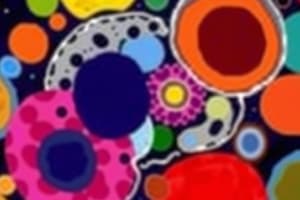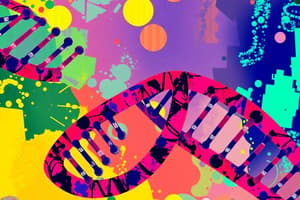Podcast
Questions and Answers
What is the main event of telophase in mitosis?
What is the main event of telophase in mitosis?
- Disjunction of sister chromatids
- Reappearance of the nuclear envelope
- Formation of cell plate in plant cells (correct)
- Uncoiling of chromosomes
What is the function of shugoshin during mitosis?
What is the function of shugoshin during mitosis?
- Contributes to cell stability
- Protects cohesin from being degraded by separase (correct)
- Holds sister chromatids together
- Connects to chromosomes via kinetochore
During which phase do chromosomes migrate to the equatorial plate?
During which phase do chromosomes migrate to the equatorial plate?
- Prophase
- Anaphase
- Metaphase (correct)
- Telophase
Which type of microtubules contribute to cell stability during mitosis?
Which type of microtubules contribute to cell stability during mitosis?
What is true about the G0 stage of the cell cycle?
What is true about the G0 stage of the cell cycle?
What happens to the nuclear envelope in prophase of mitosis?
What happens to the nuclear envelope in prophase of mitosis?
What is the main function of karyokinesis during cellular division?
What is the main function of karyokinesis during cellular division?
Why do cancer cells manage to avoid or skip the G0 phase of the cell cycle?
Why do cancer cells manage to avoid or skip the G0 phase of the cell cycle?
What characterizes interphase cytologically?
What characterizes interphase cytologically?
What is the result of separase cleaving the cohesin complex during anaphase?
What is the result of separase cleaving the cohesin complex during anaphase?
What is the main function of the endoplasmic reticulum in cells?
What is the main function of the endoplasmic reticulum in cells?
What is responsible for the oxidative phases of cellular respiration?
What is responsible for the oxidative phases of cellular respiration?
Which structure contains their own DNA and is responsible for photosynthesis?
Which structure contains their own DNA and is responsible for photosynthesis?
In which phase of the cell cycle does mitosis occur?
In which phase of the cell cycle does mitosis occur?
What is the main function of centrioles and spindle fibers in cell division?
What is the main function of centrioles and spindle fibers in cell division?
What type of filaments compose the cytoskeleton?
What type of filaments compose the cytoskeleton?
Where is genetic information carried in cells?
Where is genetic information carried in cells?
What is the end product of gene expression?
What is the end product of gene expression?
What is responsible for directing the metabolic activities of cells?
What is responsible for directing the metabolic activities of cells?
What structures are found in the nucleus of cells and contain genetic information?
What structures are found in the nucleus of cells and contain genetic information?
What is the characteristic number of chromosomes for humans?
What is the characteristic number of chromosomes for humans?
During which process do researchers observe the behavior of chromosomes?
During which process do researchers observe the behavior of chromosomes?
What are variants of a gene controlling a trait called?
What are variants of a gene controlling a trait called?
What did researchers determine was responsible for genetic information?
What did researchers determine was responsible for genetic information?
Who used X-ray diffraction to determine the structure of DNA in 1953?
Who used X-ray diffraction to determine the structure of DNA in 1953?
What are the subunits of DNA called?
What are the subunits of DNA called?
Which nucleotide pairs with adenine in DNA?
Which nucleotide pairs with adenine in DNA?
What replaces thymine in RNA?
What replaces thymine in RNA?
What is the term for the set of alleles for a given trait carried by an organism?
What is the term for the set of alleles for a given trait carried by an organism?
Homologous chromosomes are observed during which processes?
Homologous chromosomes are observed during which processes?
Flashcards
Central Dogma
Central Dogma
The process of genetic information flow: DNA to RNA to proteins.
Proteins
Proteins
Molecules made from 20 amino acids, determining cell functions and traits.
DNA
DNA
Deoxyribonucleic acid, genetic material carrying instructions for life.
Genes
Genes
Signup and view all the flashcards
Mitosis
Mitosis
Signup and view all the flashcards
Meiosis
Meiosis
Signup and view all the flashcards
Plasma Membrane
Plasma Membrane
Signup and view all the flashcards
Cytoplasm
Cytoplasm
Signup and view all the flashcards
Nucleus
Nucleus
Signup and view all the flashcards
Cytoskeleton
Cytoskeleton
Signup and view all the flashcards
Microfilaments
Microfilaments
Signup and view all the flashcards
Microtubules
Microtubules
Signup and view all the flashcards
Endoplasmic Reticulum
Endoplasmic Reticulum
Signup and view all the flashcards
Mitochondria
Mitochondria
Signup and view all the flashcards
Chloroplasts
Chloroplasts
Signup and view all the flashcards
Centrioles
Centrioles
Signup and view all the flashcards
Spindle Fibers
Spindle Fibers
Signup and view all the flashcards
Chromosomes
Chromosomes
Signup and view all the flashcards
Sister Chromatids
Sister Chromatids
Signup and view all the flashcards
Loci
Loci
Signup and view all the flashcards
Alleles
Alleles
Signup and view all the flashcards
Genotype
Genotype
Signup and view all the flashcards
Phenotype
Phenotype
Signup and view all the flashcards
Gene Expression
Gene Expression
Signup and view all the flashcards
Cell Division
Cell Division
Signup and view all the flashcards
Metabolic Activities
Metabolic Activities
Signup and view all the flashcards
Cell Structure
Cell Structure
Signup and view all the flashcards
Study Notes
- The Central Dogma is a key concept in molecular biology, describing the flow of genetic information from DNA to RNA to proteins.
- Proteins, which are made up of 20 different amino acids, are the end products of gene expression and have unique shapes and chemical properties determined by their amino acid sequences.
- Genetic information is carried by Deoxyribonucleic acid (DNA) and is organized into genes, which direct the metabolic activities of cells. Mitosis and meiosis are the major processes involved in the transmission of genetic information.
- The structure of cells includes a plasma membrane, glycocalyx, nucleus (with chromatin and chromosomes), and cytoplasm, which contains organelles and the cytoskeleton.
- The cytoskeleton is composed of interlinked proteins called filaments, including microfilaments, microtubules, and intermediate filaments, which maintain the shape and facilitate movement and anchoring of organelles.
- The endoplasmic reticulum is a compartmentalized structure that increases the surface area for biochemical synthesis, with smooth and rough variations that synthesize fatty acids, phospholipids, and proteins, respectively.
- Mitochondria and chloroplasts contain their own DNA and are responsible for the oxidative phases of cellular respiration and photosynthesis, respectively.
- Centrioles and spindle fibers are important for the movement of chromosomes during cell division and are composed of tubulin polymers.
- Chromosomes are structures found in the nucleus of cells, containing genetic information, and come in various shapes and sizes depending on their centromere positions.
- Chromosomes consist of sister chromatids, which are identical copies of the genetic material, and have specific gene sites, or loci, that carry alternate forms, or alleles.
- Genotype refers to the genetic makeup of an organism, while phenotype describes the observable traits and characteristics.
- Mitosis results in the production of two genetically identical daughter cells, and is essential for the growth and development of organisms through the formation of new cells, such as during wound healing and normal cell replacement.
- The text provides information on various cell structures and processes, including the central dogma, proteins, DNA and chromosomes, cell structure and function, the endoplasmic reticulum and mitochondria, and the relationship between genotype and phenotype.
Studying That Suits You
Use AI to generate personalized quizzes and flashcards to suit your learning preferences.





